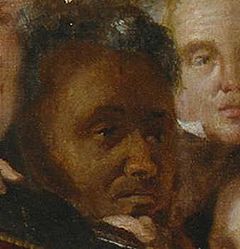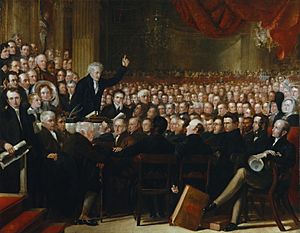Louis Celeste Lecesne facts for kids
Quick facts for kids
Louis Celeste Lecesne
|
|
|---|---|

Louis Celeste Lecesne
|
|
| Born | 1796 or 1798 |
| Died | 22 November 1847 London
|
| Education | Mr Goff's school in Kingston |
| Occupation | Victualler |
| Spouse(s) | Hannah Escoffery |
| Parent(s) | Charlotte Celeste Louis Nicholas Lecesne |
Louis Celeste Lecesne (born around 1796 or 1798 – died 22 November 1847) was an important activist who fought against slavery. He came from the Caribbean islands.
Lecesne worked to improve the rights of free people of colour. He was arrested and sent away from Jamaica with his friend John Escoffery. Their case was taken up by Dr. Stephen Lushington in Britain. Lecesne later received money as compensation after the British government agreed he was treated unfairly.
He became a strong voice against slavery. He even attended the world's first big meeting against slavery. Lecesne named his son after the British politician who helped him. He also supported the Anti-Slavery Society when it was created in 1839.
Contents
His Early Life and Birth
Louis Celeste Lecesne was the son of Charlotte Celeste and Louis Nicholas Lecesne. He was born in either Port au Prince or Kingston. The exact year was either 1796 or 1798. His parents arrived in Jamaica in 1798. His father was French, and his mother was said to have African family.
There was some confusion about where and when Louis was born. Some people thought he was born in Jamaica. Others believed he was born in Port au Prince before his family moved. This was important because a law later gave special rights to children born on the island.
In 1802, Louis went to Mr. Goff's school in Kingston. This school was for "children of colour." His father wanted him to get "the best English education."
Family Life
Louis Celeste Lecesne married Hannah Escoffery. She was born in 1797 and was also known as Anette. Hannah was the sister of John Escoffery, who became Louis's close friend and fellow activist.
Louis and Hannah had at least three children in Kingston. Their first child was Louise Amelia Lecesne, born in 1817. Then came Elizabeth Adeline Lecesne in 1818. Their third child, Celestine Aglaé Lecesne, was born in 1820 but sadly died young in 1821.
Louis and John Escoffery became well-known. They were part of a group that wanted to change laws. They believed that free men of colour should have the same rights as white people.
His Arrest and Deportation
On October 7, 1823, Louis Celeste Lecesne and John Escoffery were arrested. The Governor of Jamaica, the Duke of Manchester, ordered their arrest. They were accused of being "dangerous" and not truly British citizens. This was because some people claimed they were from Haiti.
While they were in jail, friends asked the Governor to release them. These requests were turned down. Luckily, Louis and John were able to ask the Supreme Court of Jamaica for a Habeas Corpus writ. This is a legal order that makes authorities bring a prisoner to court to explain why they are being held.
The judges decided that Louis and John were British-born. They were released without bail because there were no charges against them.
However, a secret committee was formed in Jamaica to look into their case again. This committee decided to force Louis and John to leave Jamaica. They were sent to St. Domingo (Haiti). It was claimed they had helped with a rebellion and had secret letters with people in Haiti.
Louis and John were separated from their families. They had to sell their watches to get money. With help from British people, they traveled to England. Even though they were deported, the movement for free coloureds' rights in Jamaica did not stop. Other campaigners, like Edward Jordon and Robert Osborn (Jamaica), continued the fight. They eventually succeeded, and free coloureds gained the right to vote and hold public office.
A young English sailor named Barnet Burns had been sick in Jamaica. Louis and his family had cared for him. After Louis was deported, Barnet followed his family to London. There, Louis helped Barnet get an education.
Fighting for Justice in England
The case of Lecesne and Escoffery was brought up in the British Parliament. Stephen Lushington, a well-known anti-slavery campaigner, spoke about their unfair treatment in 1825.
There was also a court case in Britain. A book had said that Jamaican politicians believed Louis and John were guilty of a crime. This case proved that Louis and John were innocent. Because of this, the British Parliament ruled that they should be allowed to return to Jamaica. They were also given money as compensation for what they had suffered.
Louis Celeste Lecesne continued his work in England. In 1832, he joined the board of the Anti-Slavery Agency. He worked with other important abolitionists like William Allen and Zachary Macaulay.
While in London, Louis and Hannah had another son. They named him Stephen Lushington Macauley Lecesne. He was born in 1834.
The 1840 Anti-Slavery Convention
In 1840, the British and Foreign Anti-Slavery Society was created to fight for the end of slavery everywhere. Soon after, the first World Anti-Slavery Convention was held in London. People from many countries attended. Louis Lecesne was there and is even shown in a famous painting of the event called The Anti-Slavery Society Convention, 1840.
Louis Celeste Lecesne passed away on November 22, 1847, in London, after getting sick with pneumonia.



